How do the best SaaS companies do social media marketing?

A bit of a longer read, but a lot of examples and helpful tips (i think?)
The majority of big SaaS companies do social media advertising, and with the help of Facebook's ad library, we can actually see what ads are they running on Facebook and Instagram. This is why i decided to see how do the ads look, what lessons we can learn from them, and share them with you.
I just want to take a moment to say how much i am amazed by the Ad Library. To be able to see the ads that companies like HubSpot or Salesforce run is pure gold to me (and to many aspiring startup founders), because it can be a great starting point for many things: if i want to start running paid ads - check how the big players are doing it; if i want to create new templates for Plainly - check how do the ads look. It's a huge timesaver.
When i decided to do this post, i imagined that i will take 10 SaaS companies, see what ads they are running and write my conclusions, i also imagined that much more of them will run video ads and that i will be able to create a whole blog post about that buuuuuuuut it turned out just a bit harder. You see, a lot of companies aren't currently running Facebook and Instagram ADs and that might be due to the boycott or that they decided to run different marketing strategies - whatever it is it made my job a bit harder.
Nonetheless, let's stop moaning and share my learnings with you!
(BTW this post was adapted from our blog, because i like you folks but if you want to give us that sweet traffic, check out plainly.shop/blog)
Salesforce

They dub Salesforce as the heavyweight champion of CRM's, and i agree with them. It has the biggest market share of all CRM's and it had a revenue of 17.1 billion in 2020 and it has almost 50,000 employees!
They set the path for future CRM's and they are a leader in that category, but how do they advertise on social media?
When looking at their ad library we can see that they aren't currently running ads, but we can see some of their older ones - and at the image above you can see the one they've been running for the longest time.
A nicely designed ad that states that by clicking on it you will be able to learn how to keep your mobile workers confident and motivated. When you click on it leads you to a landing page that offers a free guide. This 'lead magnet' allows them to gather the leads and put them into their marketing funnel. Once you sign up for this you will start seeing much more of their ads and you will start receiving their marketing emails. They use the same design both on the ad and on the landing page, and this is to clearly show you that you got there through the ad.
This is a very common practice, offering a piece of content for your e-mail and it's a great way to capture leads because it brings value to the user and they gain trust in you - it also helps to qualify leads because if they are willing to give the e-mail that means that they are much more interested in the service you are offering than somebody who didn't commit.
Drift
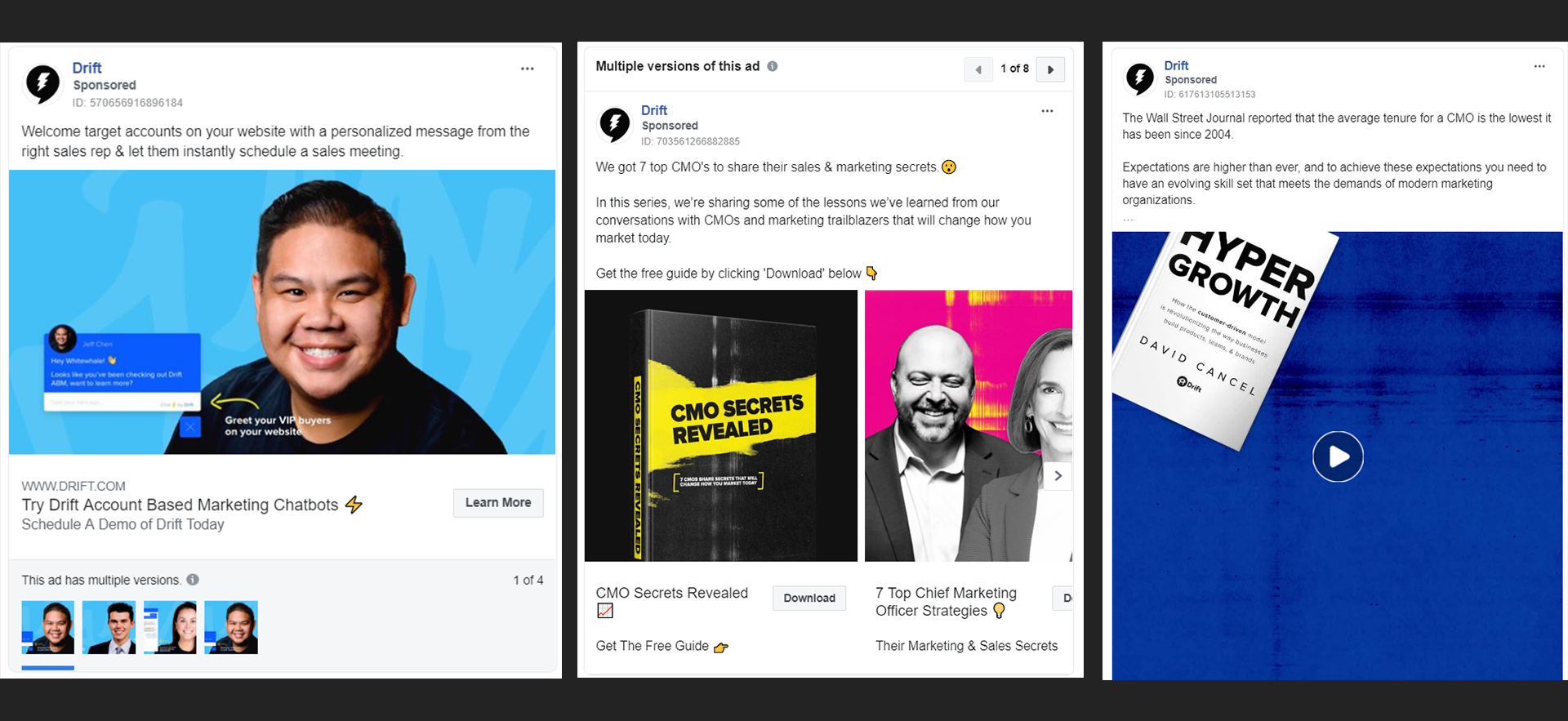
Drift is a great little tool that you add to your website so you are able to talk to your customers instantly while they are on your website. They want to "move marketing" from the old ways and to move it closer to conversational marketing.
They are trying a few different ad tactics, as we can judge from their ad library.
The first ad you can see is really helping us understand that your leads are talking to a real person on the other side, and they want us to get that easily by placing a human being with their software in the corner. In the text portion of the ad, you can see the unique selling proposition - move the leads faster.
The second and third example are offering a lead magnet, which is a really popular tactic as you will see (and you've seen on the Salesforce example). I really like the second example, that "CMO Secrets Revealed" copy really draws me in and i'd happily give my e-mail for their "secrets".
If you are an aspiring startup founder like me, you can look into your network and seek industry expertise (if you don't have any) and try to copy this kind of lead magnet.
Grammarly
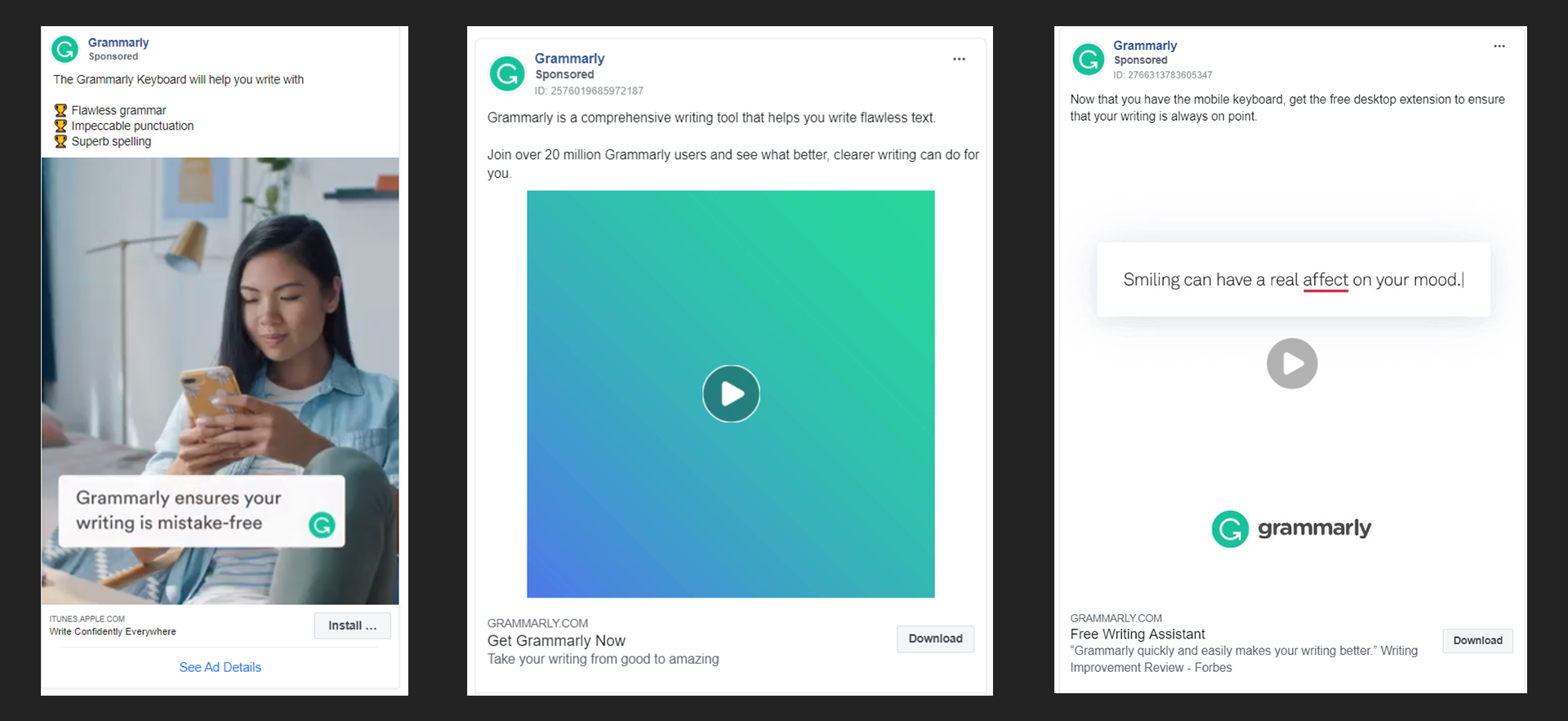
Grammarly is a free browser extension that helps you fix writing mistakes. It's a great tool that shows all of your writing mistakes, and it suggests alternatives to fix it - it's also a great way to expand your writing abilities as it sometimes suggests how to fix clunky sentences.
Their ads are pretty simple. If you check their ad library you can see that they use a lot of emojis in their text portion and the rest of the ads is simple.
They clearly display the unique selling proposition with clear to read text and simple design. They also seem to use a mix of static and video ads. The video ones are pretty interesting because they explain what Grammarly is and what it does in a visually appealing, and short manner.
Hootsuite

Hootsuite is a social media management platform that allows you to, among other things, schedule your social media posts across multiple social networks. They are one of the pioneers of social media automation and they are liked by thousands of companies.
What we can observe from their social media ads is that they are really pushing the 60-day free trial that they got going on. Their ad library is full of static images with pretty design with a clear to read, big text. The design of these ads is really nicely done because it highlights the things that we need to see, which is the text - telling us what will their software bring us.
One interesting tactic that they are using is that they are advertising their social proof (as you can see in example two). They are prominently displaying that they've got hundreds of Fortune 1000 companies and that they are pioneers of this field. This really tells us that we can trust them and makes them jump out from the companies that are only advertising their features.
Hubspot
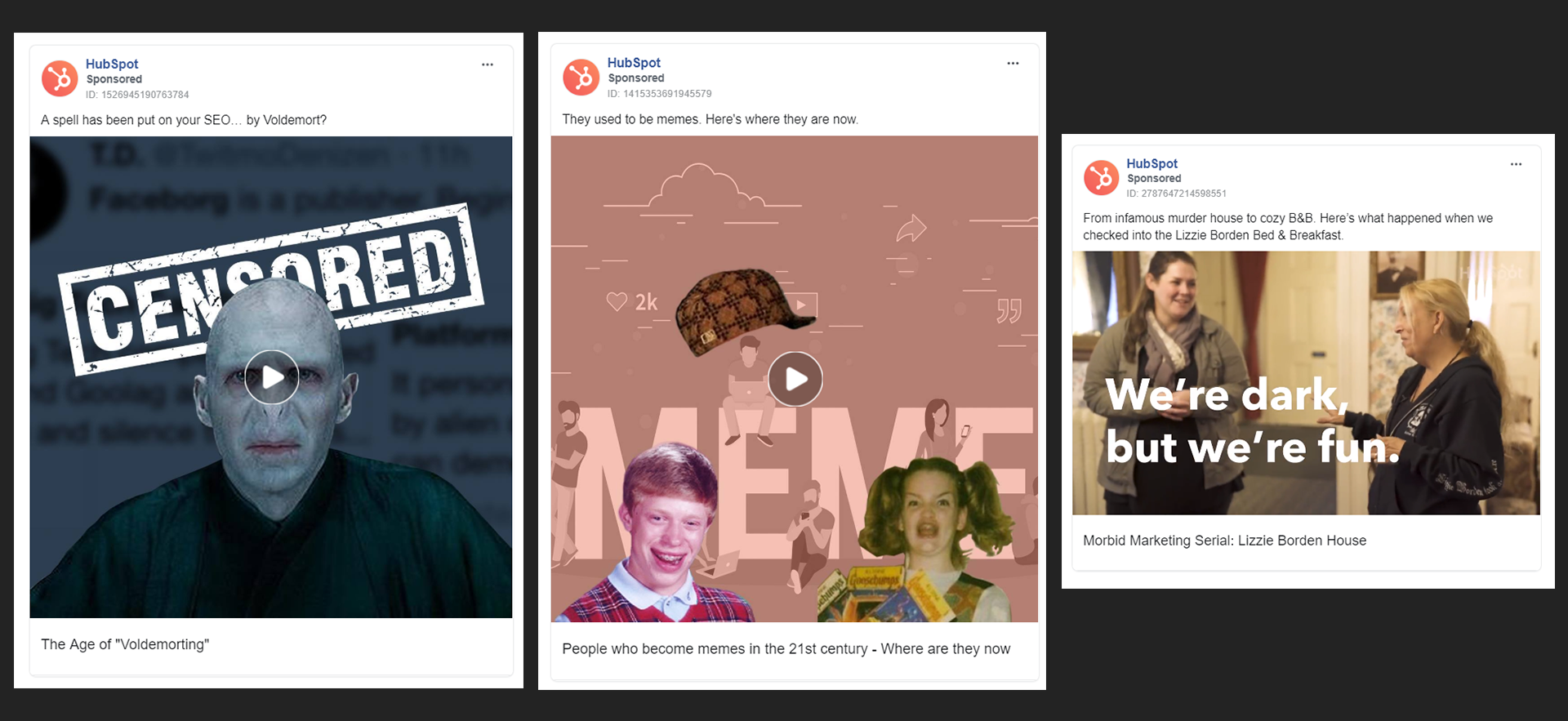
Hubspot is THE inbound marketing platform, widely recognizable it employs over 4000 people and it brought inbound marketing to the mainstream in 2010.
Okay, so among classic simple ads displaying a unique selling proposition in a nicely designed format, they have some AMAZING pieces of content.
I actually got really distracted by doing this research because i watched like 10 of their ads, and then i realized how genius their marketing tactic is. I am no marketing expert, so the following opinion comes purely out of common sense and my limited marketing knowledge but i think they have little to no conversions from these ads BUT the brand awareness gains from these is probably huge.
They have dozens of really interesting short videos covering really interesting topics, as you can see in the pictures above, for example, one of those is "People who become memes in the 21st century - Where are they now"....i mean who thought of this? It obviously has nothing to do with inbound marketing, but it's engaging, it fun to watch and i think this is a great piece of content that gets them a ton of benefits.
Intercom
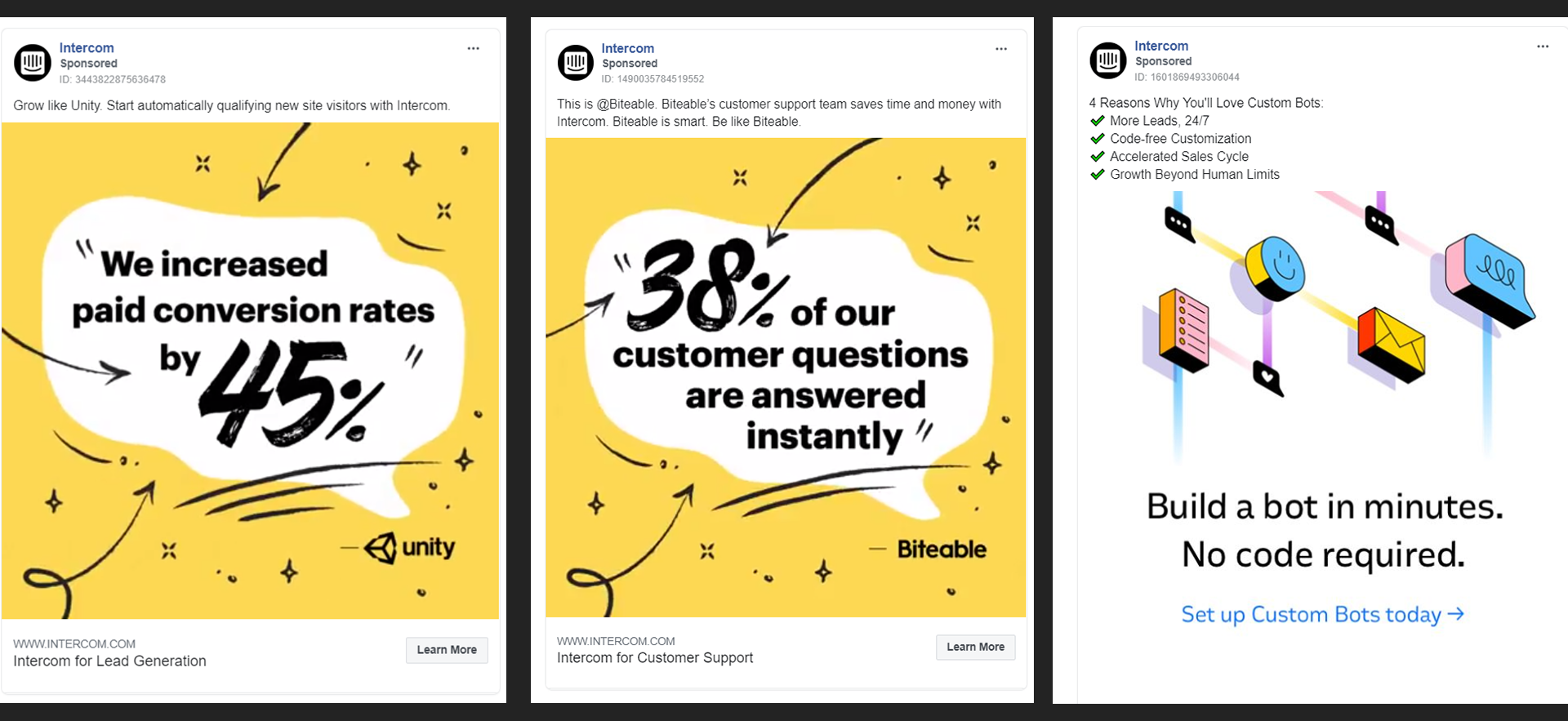
Intercom is a similar tool to Drift, offering its customers a help desk integrated to their website. It's a customer messaging platform that offers support and marketing services keeping their client connected with their customers.
They seem to be full into a social proof marketing tactic. They are boldly displaying the benefits their customers have, really drawing my attention to their ad, because who doesn't want to have their paid conversion rates up by 45%??
Using social proof is a great way to build relevance, and displaying your customer's testimonials is a great way to say: "Hey we are legit, look at these benefits our customers got". Of course, this is a bit harder to achieve when you have zero or a small number of customers but as soon as you get some customers you should ask for testimonials.
Miro
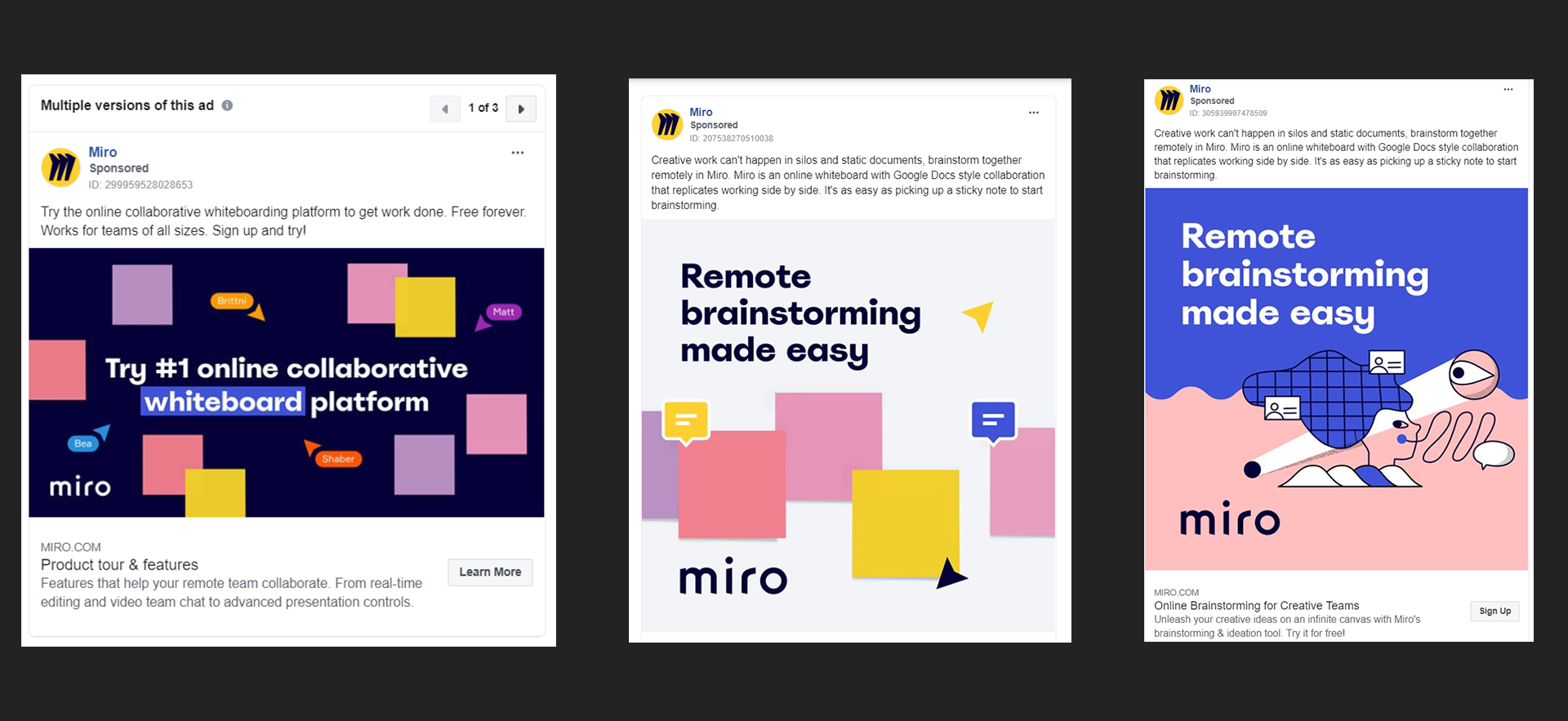
Miro is an online whiteboard built for remote teams. They boast with 5+ million users and they are intended to support the whole remote working culture. They want to bring closer the brainstorming dynamics to the remote workers.
Judging by their ads their message is clear - we are THE online collaboration tool, and they are prominently displaying that. We can see that literally all of their ads display the same thing.
They are using a lot of static ads with pretty, eye-catching design...some of it a bit weird sometimes which is also good because it makes you stop and say "What the hell is that?".
Shopify
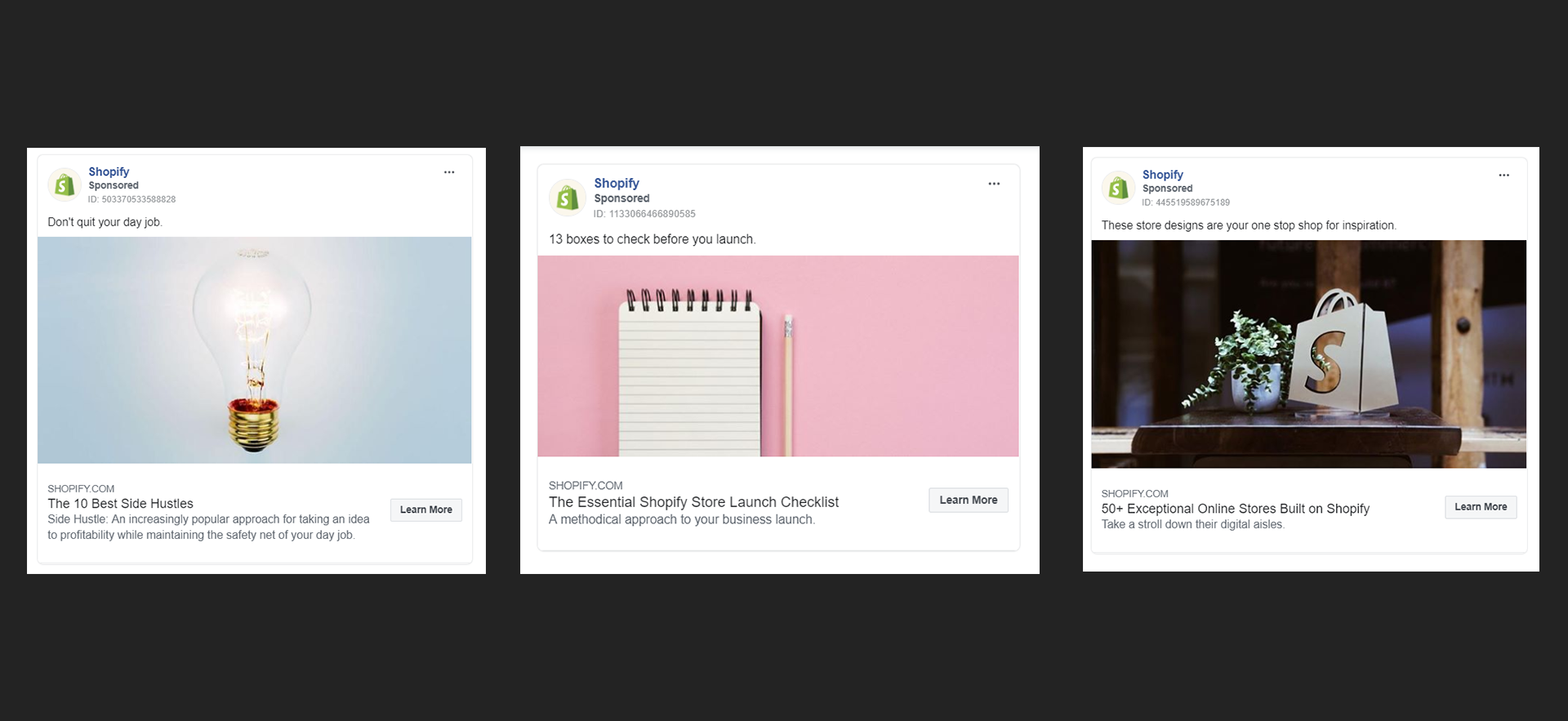
Shopify is the best E-Commerce shop builder and a starting point for many new E-Commerce shops. They are the driving force of the E-Commerce revolution because thanks to them it was never easier to build an online shop.
What i could see from their ad library is that they advertise a lot of their content, which is a tactic a lot of SaaS companies do. Instead of plainly advertising your product, you advertise the content you are creating and that brings the traffic to your website.
Their articles are fun to read, very knowledgeable and they can help anybody who wants to start an online shop - and this way they qualify their leads because if someone is not interested in their articles they probably won't be interested in Shopify.
SurveyMonkey
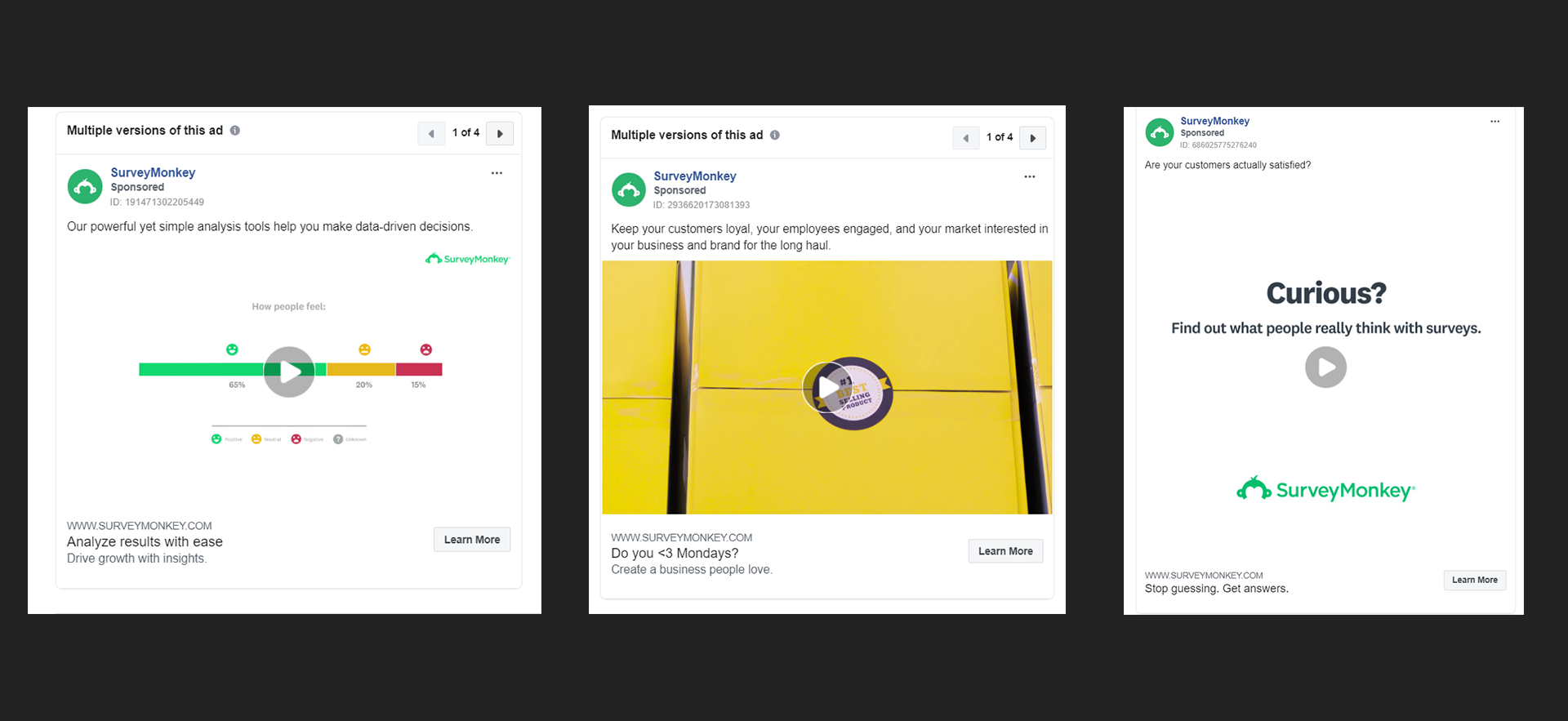
SurveyMonkey is a cloud-based survey tool that helps you see what your customers think about your product. They allow you to create and collaborate with your team on the surveys, and they are the leader in the survey space.
Their marketing is simple, but a big difference that i can notice is that they use a looooot more of videos than still images. Their videos grab attention quickly, draw you into them, and explain what SurveyMonkey does. One thing that kinda throws me off is that they aren't using more of their green color, i think it would stand out much more in the social media feed than the white that they are primarily using right now.
When creating ads, in my experience it's crucial to have catchy colors because otherwise, it will just blend with the social media feed. That's why i am always trying to include eye-catching colors in the first few seconds of Plainly's templates.
Recap
It's been challenging to find all of these examples and actually draw some conclusions from them, but now when i am at the end of the road - i can say that i learned a lot, and i hope you did too.
I want to note that these are not professional marketing advice, as i am not a marketing guy but these were just meant as a fun way to learn how the best SaaS companies do marketing from a standpoint of somebody who knows just a bit about marketing.
If you liked this article, you might also like some of my previous ones - check out my profile or check out plainly.shop/blog for more.
If you think i made some mistakes, please point them out in the comment below, i'd love to hear from you.
Anyhow, i hope you had fun and learned something. Thanks for reading!

Great review, Nebojsa! Thanks for sharing!
Thanks David!
You're welcome, Nebojsas.